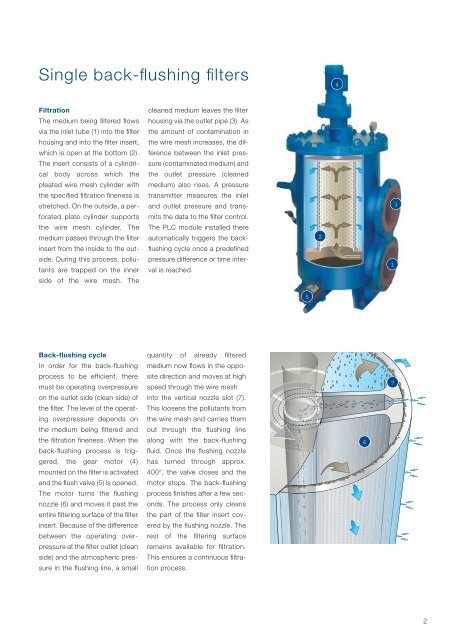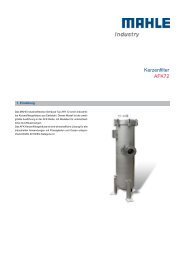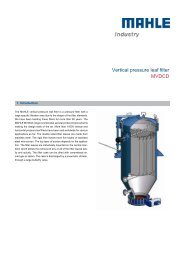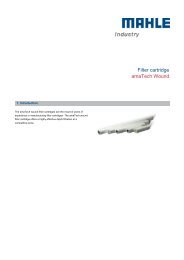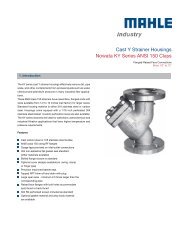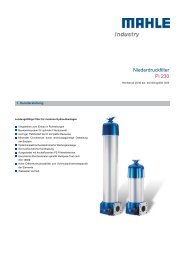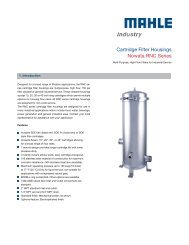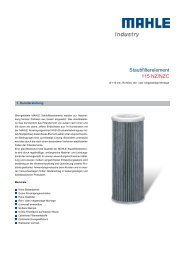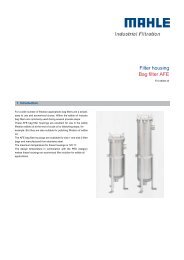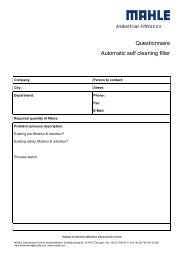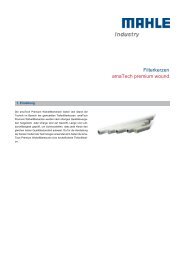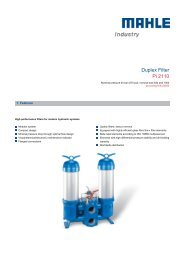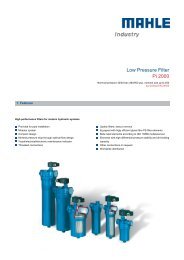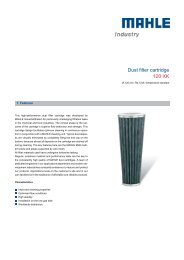CLEAN SOLUTIONS - MAHLE Industry - Filtration
CLEAN SOLUTIONS - MAHLE Industry - Filtration
CLEAN SOLUTIONS - MAHLE Industry - Filtration
You also want an ePaper? Increase the reach of your titles
YUMPU automatically turns print PDFs into web optimized ePapers that Google loves.
Single back-flushing filters<br />
4<br />
<strong>Filtration</strong><br />
The medium being filtered flows<br />
via the inlet tube (1) into the filter<br />
housing and into the filter insert,<br />
which is open at the bottom (2).<br />
The insert consists of a cylindrical<br />
body across which the<br />
pleated wire mesh cylinder with<br />
the specified filtration fineness is<br />
stretched. On the outside, a perforated<br />
plate cylinder supports<br />
the wire mesh cylinder. The<br />
medium passes through the filter<br />
insert from the inside to the outside.<br />
During this process, pollutants<br />
are trapped on the inner<br />
side of the wire mesh. The<br />
cleaned medium leaves the filter<br />
housing via the outlet pipe (3). As<br />
the amount of contamination in<br />
the wire mesh increases, the difference<br />
between the inlet pressure<br />
(contaminated medium) and<br />
the outlet pressure (cleaned<br />
medium) also rises. A pressure<br />
transmitter measures the inlet<br />
and outlet pressure and transmits<br />
the data to the filter control.<br />
The PLC module installed there<br />
automatically triggers the backflushing<br />
cycle once a predefined<br />
pressure difference or time interval<br />
is reached.<br />
2<br />
1<br />
3<br />
5<br />
Back-flushing cycle<br />
In order for the back-flushing<br />
process to be efficient, there<br />
must be operating overpressure<br />
on the outlet side (clean side) of<br />
the filter. The level of the operating<br />
overpressure depends on<br />
the medium being filtered and<br />
the filtration fineness. When the<br />
back-flushing process is triggered,<br />
the gear motor (4)<br />
mounted on the filter is activated<br />
and the flush valve (5) is opened.<br />
The motor turns the flushing<br />
nozzle (6) and moves it past the<br />
entire filtering surface of the filter<br />
insert. Because of the difference<br />
between the operating overpressure<br />
at the filter outlet (clean<br />
side) and the atmospheric pressure<br />
in the flushing line, a small<br />
quantity of already filtered<br />
medium now flows in the opposite<br />
direction and moves at high<br />
speed through the wire mesh<br />
into the vertical nozzle slot (7).<br />
This loosens the pollutants from<br />
the wire mesh and carries them<br />
out through the flushing line<br />
along with the back-flushing<br />
fluid. Once the flushing nozzle<br />
has turned through approx.<br />
400°, the valve closes and the<br />
motor stops. The back-flushing<br />
process finishes after a few seconds.<br />
The process only cleans<br />
the part of the filter insert covered<br />
by the flushing nozzle. The<br />
rest of the filtering surface<br />
remains available for filtration.<br />
This ensures a continuous filtration<br />
process.<br />
6<br />
7<br />
2


